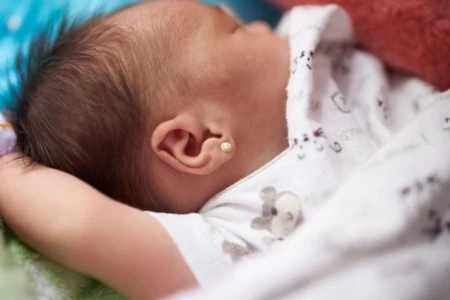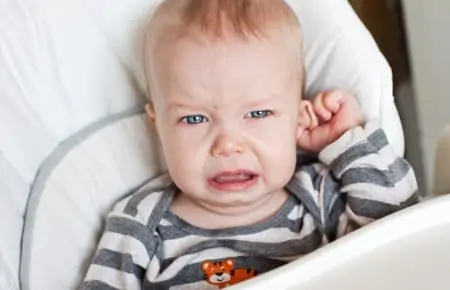Ear infections are a common blight of childhood. If your little one hasn’t yet experienced an ear infection, they likely will at some point. Knowing what ear infections look like and the steps you can take to treat them can help you prepare for the experience.
Your best defense is arming yourself with the knowledge to help you tackle ear infections head-on and give your child the care they need.
As ear infections are one of the most common issues pediatricians deal with in little ones, we’ve learned a lot about how to help them through the process. In this article, we’ll share our knowledge of why and how ear infections happen and explain how you can avoid them.
Key Takeaways
- Ear infections occur in the middle ear and are common in young children due to their small eustachian tubes.
- Common symptoms include fever, unusual behavior, ear pulling, difficulty sleeping, and lack of appetite.
- Treatment often involves antibiotics, pain relief, and keeping the child hydrated.
- Prevention strategies include handwashing, avoiding smoke exposure, breastfeeding, keeping the baby upright during bottle feeding, treating allergies, and vaccinating.
What Is an Ear Infection?
An ear infection happens in the middle ear, behind the eardrum in the eustachian tube. Inflammation, fluid build-up, and pressure usually accompany the ear infection. Several days of nasal congestion or a runny nose can precede the development of an ear infection. This can make for a miserable experience, especially for young children who can’t vocalize or understand why they’re uncomfortable.
There are two general types of ear infections — acute and chronic. Chronic ear infections never seem to truly resolve, or they come back shortly after treatment (1).
Acute ear infections are short-lived, although they may be painful. These ear infections may follow a cold or illness where the sinuses are heavily involved. Your doctor will likely treat both acute and chronic ear infections with antibiotics.
Identifying the cause of the infection is especially important for chronic ear infections that indicate an ongoing problem. Once identified, you can begin to make the necessary changes to help avoid those conditions in the future.
Why Do Ear Infections Happen?
The eustachian tube runs from the ear to the back of the throat. These tubes are responsible for tying the ears into the sinus system.
The eustachian tubes are small, even in an adult. In young children, they are both smaller and shorter. They also form a horizontal connection between the nasal cavity and the middle ear. This allows any nasal fluid to flow easily into the middle ear. After a few days, bacteria can begin to grow there (2).
Blockages and backups in these tubes can happen easily. Young children are encountering germs and viruses for the first time and are regularly sick. These two situations together contribute to the high rate of ear infections in young children.
While ear infections tend to always operate similarly, their catalysts can differ. These are some potential ear infection causes:
- Colds.
- Allergies.
- Adenoid complications (inflammation or infection).
- Excessive mucus production.
- Exposure to secondhand smoke.
Young babies who are bottle-fed and those who use pacifiers may be at a greater risk for ear infections. Babies born prematurely are also more prone to ear infections (4).
Does Your Baby Have an Ear Infection?
You will rarely be able to identify whether your baby has an ear infection by looking at the outside of the ear.
Are you on the fence about whether you should seek treatment for a potential ear infection? Here are some indicators you should make an appointment with your doctor.
- Fever: Fevers that accompany ear infections are usually high. Because they are directly related to the body fighting the infection, they will reoccur when your child is not being medicated with ibuprofen or acetaminophen.
- Unusual behavior: Is your usually upbeat baby or toddler suddenly inconsolable and clingy? These behaviors can indicate they are battling an ear infection.
- Ear pulling: Young children may pull, tug, or claw at their ears during bouts of pain. If you notice your child cupping, holding, or paying more attention to their ear than usual, it may indicate an ear infection.
- Difficulty sleeping: Lying down can exacerbate pressure-related discomfort and make nighttime a nightmare. When a child who tends to go to bed easily and sleep soundly through the night suddenly can’t fall asleep or wakes up crying, they may be dealing with an ear infection.
- Lack of appetite or interest in food: When a child has an ear infection, it may impact their regular appetite and eating behaviors.
- Foul or unusual odor: An unpleasant odor often accompanies infections. If you notice foul-smelling ears, you’ll want to see your doctor.
- Drainage: If you notice any pus-like drainage, don’t delay having your child’s ears evaluated. Your little one may have an infection that’s become severe enough to perforate the eardrum. The sooner this is treated, the better.
Any of these signs can appear in a baby or young child for another reason altogether. Growing pains and teething might impact sleeping behavior. Normal development stages may explain clingy behavior and anxiety.
However, if your child experiences several of these symptoms, you will need to rule out an ear infection. Leaving an ear infection untreated can cause permanent damage to the ear and impair their hearing (5).
If you’re concerned, it’s worth visiting the pediatrician. Using an otoscope, your doctor can easily assess the ear’s condition. If an ear infection is diagnosed, the doctor will likely prescribe an antibiotic medication.
How to Relieve Ear Infection Pain
With an effective antibiotic, your child can start experiencing relief from ear infection discomfort after just one dose. You can help make them comfortable while the antibiotics are at work by taking the following steps.
- Pain relief: Choose your pain reliever of choice, and use it to keep inflammation down and the pain in check.
- Keep your baby hydrated: Your child may not be interested in eating or drinking because swallowing may be uncomfortable. However, if they become dehydrated, it will only add to their discomfort and lengthen the recovery time. Depending upon your child’s age, you might try giving a popsicle as children seldom refuse them!
- Indulge them: Go ahead and let your little one snuggle up to you and soak up some cuddles. You can’t hurry the healing process, but some quality time doing your child’s favorite things might make the time pass quicker.
I commonly recommend acetaminophen or ibuprofen for ear pain relief. Some parents ask me about using warm oil drops (garlic oil or olive oil), but I do not recommend this, especially if there is a potential eardrum perforation. Some doctors prescribed benzocaine ear drops to numb ear pain in the past, but they no longer recommend this (6).
Editor's Note:
Dr. Leah Alexander, MD, FAAPIf you don’t notice a significant improvement in 48 to 72 hours, you should call your pediatrician and ask to be seen again. It’s possible your prescribed antibiotic isn’t working for the infection. Your doctor can quickly look at the ear and determine if they need to prescribe a different antibiotic.
You’ll want a follow-up visit with your doctor four to six weeks after treatment. This will give the ear enough time to heal and prevent a recurrent infection from trying to set up shop again. Catching an ongoing problem early on will be in your child’s best interest.
How to Prevent Ear Infections
Ear infections may be an unavoidable part of childhood. But you can do a few things to lessen your chances of encountering them.
- Always practice thorough handwashing. This will cut down on the germs that can cause illnesses that could lead to secondary infections in the ear.
- Don’t smoke or expose children to smoky places. Ask visiting friends or family to smoke outdoors. Exposure to smoke increases the likelihood of ear infections.
- Breastfeed your baby. This provides helpful antibodies that can help protect them from germs that can lead to colds and ear infections.
- When bottle feeding, keep your baby upright. Eating while lying down can allow milk or formula to slide back in the throat and become trapped in the eustachian tubes.
- Treat allergies — excessive mucus production can lead to impacted eustachian tubes and ear infections. Keeping that mucus in check can help you avoid ear infections.
- Vaccinate your children. Research shows children who receive their vaccines are less likely to experience ear infections (7).
Do what you can where you can to help prevent ear infections. Even if it only means you avoid one or two things, not having to watch your child suffer through the experience will be more than worth it.













